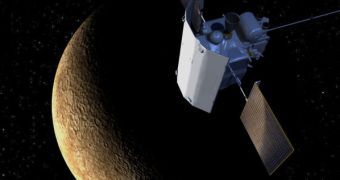The NASA MErcury Surface, Space ENvironment, GEochemistry and Ranging (MESSENGER) probe has just recently performed its third flyby of Mercury, and it is currently heading on a course that will allow it to be captured in the planet's orbit in early 2011. As it passed close to the planet after one of its third approaches, the spacecraft's instruments started recording a large number of high-energy solar neutrons, which is amazing, considering that this is the first time these particles have been studied within a distance range smaller than one astronomical unit (AU) from the Sun, Space Fellowship reports.
The solar flare was detected by the spacecraft on December 31, 2007, as it was cruising about half of one AU away from the Sun. The readings obtained by the spectrometers aboard the probe helped astronomers finally figure out why some coronal mass ejections produced little to no energetic protons, whereas others did. “What [the observations are] telling us is that at least some moderate-sized flares continuously produce high-energy neutrons in the solar corona. From this fact, we inferred the continuous production of protons in the 30-to-100-MeV (million electron volt) range due to the flare,” Planetary Science Institute scientist William C. Feldman says.
“So the important results are that perhaps after many flare events two things may occur: continuous production of neutrons over an extended period of time and creation of seed populations of neutrons near the sun that have decayed into protons. When coronal mass ejections (nuclear explosions in the corona) send shock waves into space, these feedstock protons are accelerated into interplanetary space,” he adds. Analyzing the properties of energetic protons is highly important for NASA, because these elementary particles travel at very high energies, and can cause massive damage to satellites in the Earth's orbit, and to astronauts aboard the International Space Station (ISS).
“There has always been the question of why some coronal mass ejections produce almost no energetic protons that reach the Earth, while others produce huge amounts. It appears that these seed populations of energetic protons near the sun could provide the answer, because it’s easier to accelerate a proton that already has an energy of 1 MeV than a proton that is at 1 keV (the solar wind),” Feldman adds. “People in the manned spaceflight program are very interested in being able to predict when a coronal mass ejection is going to be effective in generating dangerous levels of high-energy protons that produce a radiation hazard for astronauts,” he concludes.

 14 DAY TRIAL //
14 DAY TRIAL //